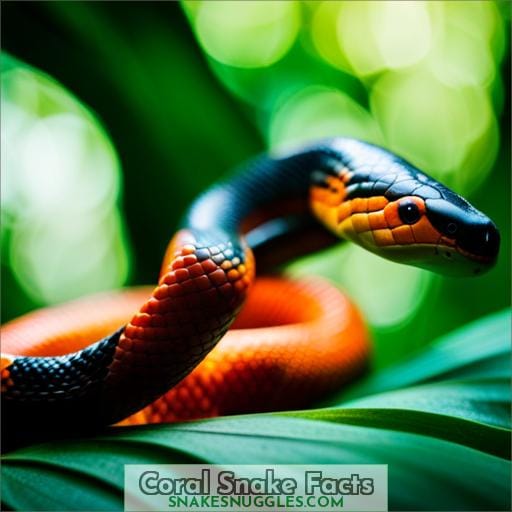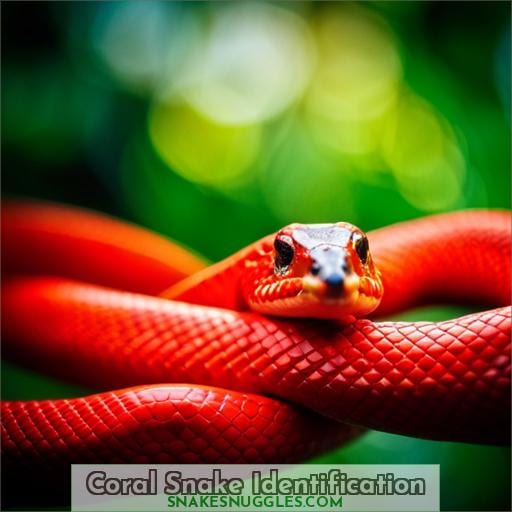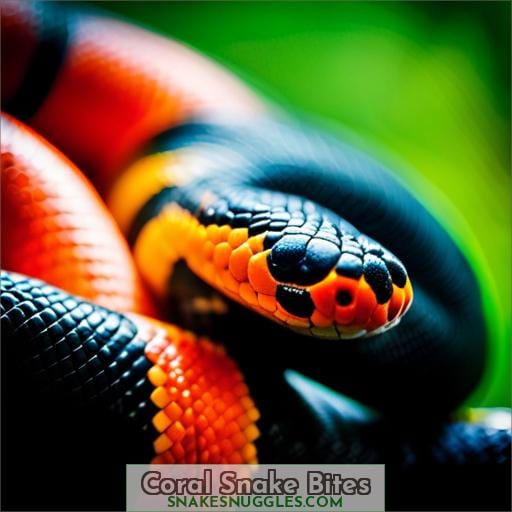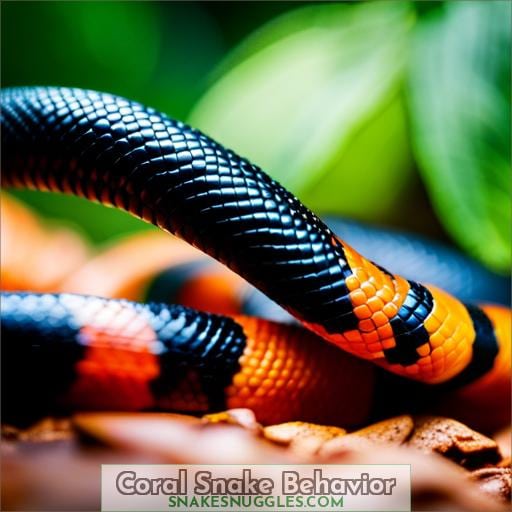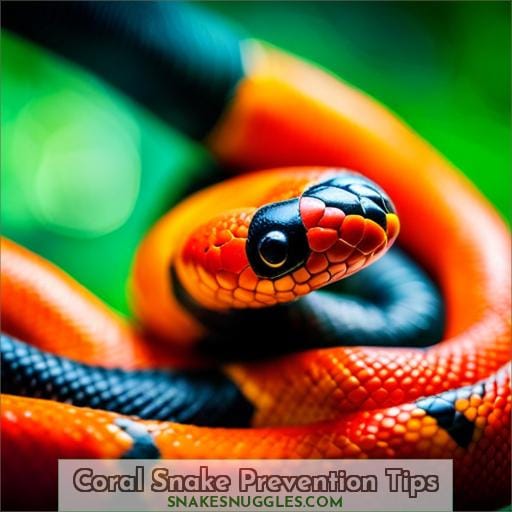This site is supported by our readers. We may earn a commission, at no cost to you, if you purchase through links.
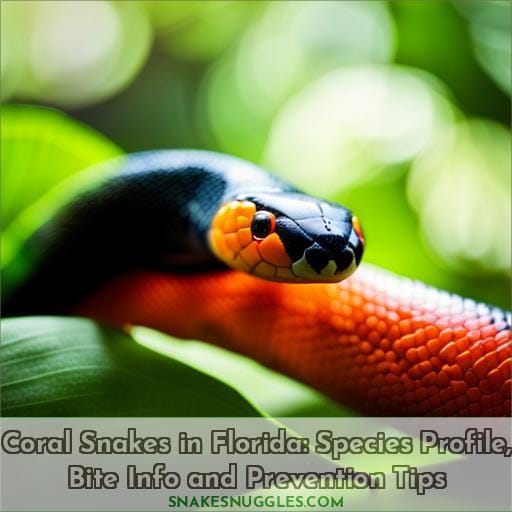
Get the latest research on:
- Identification tips
- If you’re bitten by a coral snake, follow proper snake wound care at home by remaining calm and moving away. Bite first aid. When bitten by a venomous snake, it’s crucial to remain calm and follow proper snake wound care tips
- Prevention
Stay safe in coral snake country, but don’t fear them; learn how coexistence with these shy, reclusive reptiles is easily done.
Table Of Contents
- Key Takeaways
- Coral Snake Facts
- Coral Snake Identification
- Coral Snake Bites
- Coral Snake Behavior
- Coral Snake Prevention Tips
- Frequently Asked Questions (FAQs)
- What are the key differences between coral snakes and similar-looking nonvenomous species?
- How quickly do coral snake bites take effect and how long do the effects last if untreated?
- What first aid measures should you take if bitten by a coral snake?
- Are there any effective folk remedies or home treatments for coral snake bites?
- What should you do if you spot a coral snake around your home or in your neighborhood?
- Conclusion
Key Takeaways
- Coral snakes have potent neurotoxic venom that requires immediate medical treatment with antivenom.
- Coral snakes tend to be reclusive and shy, preferring undisturbed natural habitats.
- Proper coral snake identification requires a field guide, as color patterns vary within species and rhymes are unreliable.
- Bite prevention involves avoiding natural habitats, wearing protective clothing, and educating children.
Coral Snake Facts
You’ll find eastern coral snakes living in scattered populations across Florida.
They can be distinguished from lookalike species like scarlet kingsnakes by their alternating red, yellow, and black banding pattern.
Read on to learn how to properly identify coral snakes and prevent bites from these venomous yet shy serpents.
Range in Florida
You’ll find the Eastern coral snake primarily in the southern half of Florida.
- Extreme south: Everglades region
- Central east: Brevard and Indian River counties
- Western coast: Tampa to Naples
- Less common north of Orlando
- Habitats: pine flatwoods, scrub, hammocks, wetlands
Comparison With Other Species
You compare the coral snake to other venomous and nonvenomous species in Florida.
The coral snake’s potent neurotoxic venom differs from other venomous snakes in the state.
Its shy, retiring nature also contrasts with the more aggressive behaviors exhibited by rattlesnakes and cottonmouths.
However, the coral snake’s coloration and patterns can cause it to be confused with the nonvenomous scarlet kingsnake.
Being able to distinguish coral snakes from lookalikes is crucial for bite prevention and safety around all snakes.
Coral Snake Identification
Species Profile, Bite Info, and Prevention Tips:
When identifying coral snakes, don’t rely solely on rhymes or mnemonics. Instead, focus on key characteristics such as color patterns, scale textures, head shapes, and geographic ranges.
Color Patterns
After learning about coral snake facts in Florida, you’ll want to carefully examine color patterns when trying to distinguish coral snakes from other species.
Color patterns can vary within the same species.
The red-touching-yellow/black-touching-red rhyme is unreliable for identification.
Evolutionary pressures likely drove the development of color pattern mimicry between venomous coral snakes and nonvenomous species.
Factors like age, environment, genetics influence color expression in snakes.
Rhymes
Don’t rely on rhymes to distinguish coral snakes from similar nonvenomous species.
Color patterns vary within and between species, so rhymes are unreliable for identification.
Folklore has perpetuated myths about snake appearance that impact public understanding and safety.
Consider alternatives like learning key physical traits, viewing images, or leaving snakes alone.
Rhyme memorization continues in some regions, but education on coral snake diversity and behavior better promotes wellbeing.
Coral Snake Bites
Coral snakes can be encountered in the southeastern US and Texas. If bitten, immediate medical attention is necessary because the potent neurotoxic venom can cause delayed neurotoxicity and respiratory failure.
Coral snake bites are relatively rare, though, with only 25 to 50 out of 9000 snake bites in the US attributed to coral snakes.
The North American Coral Snake Antivenin (NACSA) is available to treat envenomation by the two medically significant coral snake species in the US: Micrurus fulvius and Micrurus tener.
This Really Happened
Turning to recent coral snake bites, four Floridians fell victim within a two-week span when they picked up serpents, erroneously thinking them harmless.
Misidentifying the coral snakes proved dire when their potent venom required emergency transport of antivenin.
Respecting wildlife by leaving all snakes alone, regardless of presumed harmlessness, prevents unfortunate human-wildlife interactions and eliminates the need for emergency response.
Educating people on proper snake identification and behavior facilitates coexistence.
Race
Unfortunately, definitive data on coral snake bites correlated with race is lacking.
While curiosity about snakes crosses cultural boundaries, some evidence suggests marginalized groups may have reduced access to information or resources for prevention and treatment.
Awareness campaigns and antivenom availability tailored to diverse communities could help address any disparities.
Most importantly, education for all on respecting snakes’ space can prevent unfortunate incidents.
Sex
Unfortunately, the data doesn’t indicate any significant differences in coral snake bites across sexes.
Both men and women are equally at risk if mishandling these venomous snakes.
Let’s move on to discussing:
- Age demographics for coral snake bites
- Reproductive habits
- Genetic diversity
- Prevention tips regarding venomous snake species in Florida
Age
With coral snake bites, victims tend to be young when playing or working outdoors.
Educational outreach on safe behavior around snakes should target youth.
Understanding age demographics and behavioral patterns can inform healthcare awareness and first-aid measures related to coral snakes in Florida.
Role of Drugs and Alcohol
In regards to coral snake bites in Florida, you’re at increased risk if under the influence of drugs or alcohol.
Intoxication impairs judgment and reactions, making avoidance and safe behavior around snakes less likely.
Maintaining sobriety and alertness in snake habitats enables quicker identification and prevention of bites.
Public awareness campaigns on snake safety should address substance influence and its behavioral impacts to promote prevention strategies.
Seasonal Variation
You’ll encounter more of these venomous snakes during their spring mating and fall dispersal seasons.
Winter Activity: Coral snakes are less active in the winter months.
Breeding Behavior: Mating season occurs in the spring.
Environmental Impact: Rainfall impacts coral snake activity levels.
Seasonal Migration: Some migration may occur in the fall.
Mortality/morbidity
Fewer than 1 in 100 snakebites in the U.S. result in death.
But you’d still better get medical help immediately if bitten.
Coral snake venom can cause delayed respiratory failure.
Though prompt medical attention is crucial and following proper snake bite first aid can significantly improve outcomes, antivenin is effective, challenges remain in quickly diagnosing coral snake bites and administering treatment.
Public awareness and emergency response continue improving.
Yet complications can still arise from these highly potent neurotoxins.
Coral Snake Behavior
Coming off discussing coral snake bites, let’s pivot to examining coral snake behavior.
Coral snakes are generally quite shy creatures.
They prefer undisturbed habitats like swamps or pine forests.
Their intricate red, yellow, and black markings camouflage them in leaf litter.
For defense, coral snakes may vibrate their tails in dry leaves as a warning.
Overall, coral snakes tend to avoid interactions in the environment.
They only bite when intentionally provoked or handled.
Some key traits defining coral snake behavior:
- Shyness and reclusive nature
- Habitat preferences for undisturbed areas
- Camouflage markings and tail vibration defenses
- Avoidance of environmental interactions
Understanding species behavioral patterns provides clues for safely coexisting with local wildlife.
Coral Snake Prevention Tips
Since coral snakes are shy and often avoid human interaction, you’ll avoid bites by taking precautions around likely snake habitats and leaving them undisturbed.
Here are four tips for preventing coral snake bites:
- Avoid disturbing natural habitats.
- Coral snakes live in sandy or marshy areas with lots of leaf litter or logs.
- Wear boots and long pants when hiking.
- Watch where you place your hands and feet.
- Keep yards free of debris piles.
- Eliminate places for snakes to hide.
- Educate children about coral snakes.
- Teach them to leave snakes alone and notify an adult.
- Venomous snake awareness can prevent many bites.
Frequently Asked Questions (FAQs)
What are the key differences between coral snakes and similar-looking nonvenomous species?
You can identify coral snakes by their red, yellow, and black color bands.
Venomous coral snakes have bands of red and yellow touching.
Nonvenomous snakes have red and black bands touching instead.
Always leave wild snakes alone, as color patterns can vary.
Identify snakes positively before handling.
How quickly do coral snake bites take effect and how long do the effects last if untreated?
Quick as a cobra’s strike, coral snake venom takes hold in minutes,
Paralyzing muscles and stopping breathing within hours
If antivenom isn’t swiftly administered.
What first aid measures should you take if bitten by a coral snake?
If bitten by a coral snake:
- Stay calm.
- Wash the bite.
- Immobilize the affected area.
- Call 911 immediately.
Do not:
- Cut the bite.
- Try to suck out venom.
Seek rapid medical attention as coral snake venom can cause delayed but serious neurotoxicity.
Antivenom can be lifesaving if administered promptly.
Are there any effective folk remedies or home treatments for coral snake bites?
Absolutely not!
There are no effective home remedies or folk cures for coral snake bites.
Immediately seek emergency medical care if bitten.
Antivenom is the only proven treatment and delays can be fatal.
Stay calm, limit movement, and get to a hospital right away.
What should you do if you spot a coral snake around your home or in your neighborhood?
If you encounter a coral snake around your home:
- Responsibly observe it from a distance.
- Alert wildlife authorities.
Leave the snake undisturbed as coral snakes are non-aggressive.
Don’t attempt to kill, capture, or handle the snake, as this risks a dangerous bite.
Simply give the snake space and let experts handle the situation.
Conclusion
Your life is in your hands.
Don’t become paralyzed by fear, but respect the coral snake’s fearsome reputation.
Stay vigilant, focused, and aware when adventuring in snake country.
Knowledge dispels danger; through understanding and common sense, we can appreciate Florida’s coral snakes from a distance.
Their striking colors brighten the wilderness, reminding us that danger often wears a mask of beauty.
Stay wise, stay safe, and let these shy serpents slither unseen.

